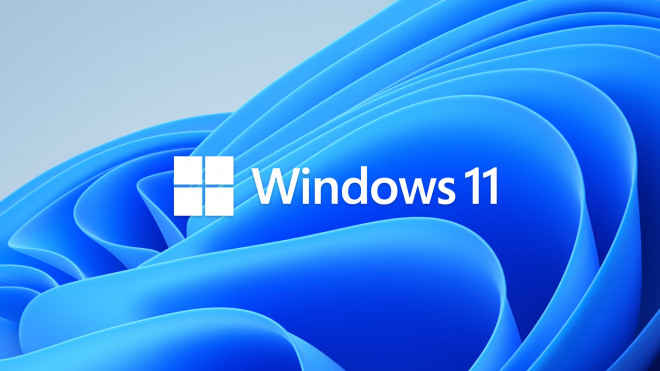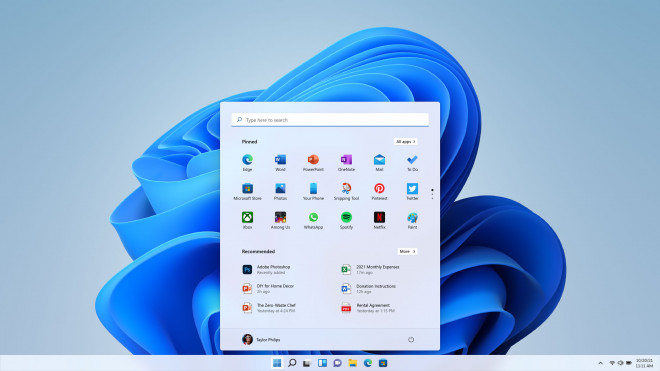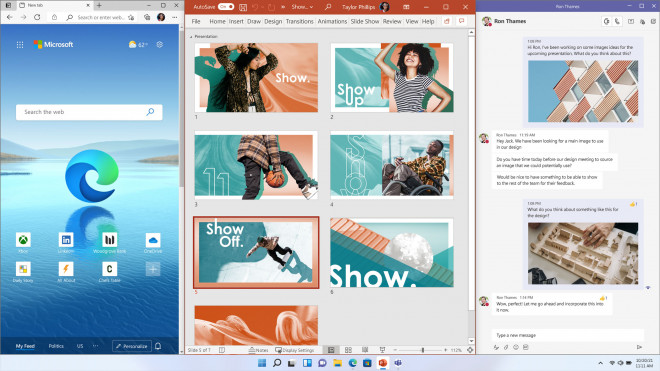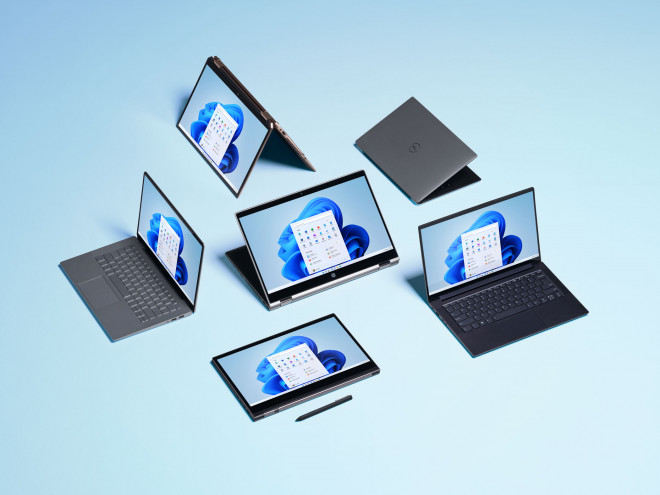For the longest time, Microsoft swore blind Windows 10 would be the last Windows–with Windows 11 being more of an inside joke among nerds. Many were surprised when, in Fall 2020, Windows 10X appeared on the scene. It was a feature-reduced Windows 10 meant for laptop and tablets, and it never saw an official release. Consequently, there were expectations that the Fall / Winter 2021 update for Windows 10 would incorporate major design changes to bring its somewhat outdated visuals up to speed. Instead, we got Windows 11! So it is reasonable to assume Windows 11 borrows heavily from both the aforementioned design overhaul and the ill-fated Windows 10X. Time to take it for a spin.
Important: The release of Windows 11 is scheduled for the fourth quarter of 2021 so the current beta is subject to change.

Initial test run
Right from the start (menu), it becomes immediately apparent Windows 11 is doing away with old shibboleths: The menu is centered in the task bar by default! Microsoft (again) want to ready its OS for all kinds of devices, including humongous (touch) displays. Live tiles are gone, everything feels more streamlined and focused. Search is located at the top, with pinned applications directly below, and recommendations (including your most recent documents) down at the bottom. Similar to macOS, corners are now rounded giving the visuals an overall sleek look, especially in tandem with the stained-glass effect (Windows 7 anyone?) and even more especially in dark mode! The OS feels rock solid despite its beta status, no lag whatsoever. In multi-display environments, Windows now remembers the layout of application windows across multiple screens, a definite plus for creatures of habit like myself. Widgets is another born-again Windows 7 feature with support for various categories (weather, news, stocks, etc). Too much for me but different tastes for different people.
Windows, Android and the black screen of death
The new window layout feature (called Snap Layouts) is very appealing. It displays a context menu when you hover the mouse over the maximize button and supports a number of window layout options depending on the width of your display. That may not sound too fancy but it greatly helps with arranging windows in a meaningful way! The so far rather unimpressive Windows Store also gets a facelift–and a much needed boost in the shape of Android apps, further closing the gap between cellphone and PC. Exciting! Interoperability seems to be the order of the day. Gone are the times when transferring data between cellphone and PC was a chore. If you're a gamer, you'll be pleasantly surprised by Windows 11's Auto HDR support that makes everything look better (Xbox app users know what I'm talking about). And if you are afraid of the blue screen of death, you can rest easy now with the new black screen of death, very funny.

A slight learning curve
Windows always features a myriad of settings and, what began with Windows 8, continues in Windows 11: Options are moved from one place to another and redesigned. But don't despair, Control Panel is still there! The current incarnation of the settings page looks like a blend between Windows 10, macOS and Android 11. It's not a radically new design but it will take some getting used to, especially with the new icons (like the ones in Windows Explorer). Microsoft are trying to make things more accessible (commendable!), making them slightly less accessible to long-time users in the process. Remember the many Windows Update issues in 2021? In Windows 11, updates are supposed to be smaller, faster and more transparent. We'll see how that is going to play out.
Availability and price
Being a beta, Windows 11 is currently only available through Microsoft's Windows Insider program. The final release is expected to be distributed the same way Windows 10 was "offered" to Windows 7/8 users–but this time with little to no coercion. This means you'll probably see the occasional notification that a new Windows is available but, unless you hit the install button, your system will remain untouched. While it is said there will be a total of 7 different Windows 11 editions, home users will likely be given a choice between a Home and Pro edition. Being a Windows 10 upgrade, Windows 11 will be free for those users. Everyone else will likely have to purchase a license. Prices have not been announced but it is reasonable to assume they will be in the range of current Windows 10 licenses since Microsoft are naturally aiming for a high adoption rate world-wide.

Hardware requirements
This is where it gets really interesting, controversial–and somewhat complicated. The bottom line: Windows 11 will have steeper hardware requirements than its predecessor and Microsoft are not afraid to exclude older machines altogether! While tinkerers and nerds already have Windows 11 running on older devices and even cellphones, Microsoft have announced they'll be taking a much harder line upon release. You'll need a current-gen CPU, at least 64 GB of disk space, UEFI (the BIOS successor) and "Secure Boot" enabled. But that's not all: Your hardware will also have to support TPM 2.0 (powered by a hardware chip that provide security features), DirectX 12 and HD screen resolutions at minimum. That's a somewhat tall order! A brief stroll through our offices reveals that many of our own PCs do not qualify for the upgrade. Even my own office laptop, barely three years old and considered quite a beast at the time, fails to meet the CPU requirements. Its Intel i-7700 CPU, which came out just four years ago and still easily handles whatever I throw at it, is apparently not beefy enough for Windows 11!
Why so immodest, Microsoft?
Naturally, many customers fail to understand the need for these steep requirements. Microsoft's Aria Carley recently explained in a video that Microsoft want to ensure compatible devices are more productive, have a better experience and have better security. If you want the latest security features, you'll need the latest processors. Even the popular Ryzen 7 1700X and 7th-gen Intel processors fall short. Many viewers seemed unconvinced, as the now disabled comments below the video could attest to. There was immediate speculation that Microsoft are simply trying to massively push PC and Intel sales. Since most PCs around the world are likely incompatible with Windows 11, this doesn't seem too far-fetched. Especially Linux users snidely commented that great OS security rather depends on the software than the hardware. We'll see whether Microsoft will stick to this risky strategy. In any case, the current Windows 11 builds work with almost every PC so Microsoft will have to actively cut off these users from Windows 11 to make true on their announcements. If you'd like to know whether your PC can run the future Windows 11, we've got something for you: Windows 11 Compatibility Check. It's a small free tool that checks your hardware against the official requirements.

Conclusion (for now)
For a passionate Windows user like myself, this all seems exciting. Windows 11 is fun, even after several hours, and I could get used to it! Whether the upgrade is worth it for you is, as always, a highly subjective decision. In its current state, Windows 11 feels smooth and mostly devoid of growing pains, according to our testers. So kudos to Microsoft for that! The visuals look and feel nice but there's no killer feature that would prompt an immediate switch. What I can say for certain is that I would not buy new hardware just to run Windows 11. My home PCs all have a few years under their belts and almost certainly don't meet the official requirements. Still, they get the job done and will continue to do so. If you're a veteran user, you'll already have experienced a number of big leaps between Windows 95, Windows 7 and so on. This time, it's more of a small step towards a better and more logical system. If I were to buy a new PC today, I'd likely go for Windows 11.
What I would like to know: Are you planning to switch to Windows 11 provided your PC meets the requirements? Would you even consider buying a new PC?
Windows 11 Compatibility Check Download
Pics: ©Microsoft 2021




Holy $#%& I purchased and NEW all in one that had windows 11 and I think that was a mistake on my part. The all in one with windows 11 is now become a door stop at this time and I have resetup my windows10 after the windows 11 all in one would not accept any of my printers (I have five) and that means a no go on my part. Great ideas on their part to make an operating system that fwould make thing easier for us non-nerd people. This is the biggest no go I have ever bought into. I am so hurt by their new startup. It is not easy to use at all it sucks big time. I was in the windows insider program BETA channel, they lost me from the start.
I was in the Windows Insider program BETA channel. So got it early. I've downloaded the Windows for Android subsystem and gotten the Amazon store.
But it seems to have slowed my system down. I have an Alienware Aurora R10, Ryzen 7 3700X, AMD Radeon 5700XT, 32G RAM, 16TB of storage, and a new 4K 32" monitor.
I'm going to wait but may uninstall the android subsystem.
I am waiting with hope in regards to the new Windows 11
I hope everything will be a positive result.
I have an Alienware Aurora R10 with a Ryzen 7, and a laptop with an Intel Core-I5. Both run Windows 11 with ease. I am in the Windows Insider DEV channel and love it. My system seems to be more stable. Although 3 updates ago it blew out my system and I had to reinstall everything. Since then it's been great.
I wait, and keep my comment to later(!)
Will switch to Linux or something else if required to throw away three PCs that are all doing the job in order to run Windows. I have been trusting Microsoft from DOS days.
Thanks for your honest assessment of Windows 11. I have three computers, all Windows 10. All are less than 4 years old, none of which would meet the Windows 11 requirements. Appears to be Windows Vista revisited.
After a couple of hours with Windows 11, I found it killed my productivity. I have many tweaks that allows me to get things done in a fast, efficient manner which apparently have been removed and no sign of returning. I don't use Windows to perform cutesy, telephony things but rather work that computers are designed for. Just as when I first used Windows 8, I knew I would never return to Windows 7, I know that I will never move to Windows 11 unless there are major changes to allow me to operate as I prefer. One item that really ...... me off is that once MS installed W11, I am unable to return to where I was without performing a fresh copy install and removing all my many apps/programs I have installed. Apparently, I have 2-3 years to observe the transition, so I will wait and see. Being a natural experimenter, I may check out the MAC way of doing things.
I agree, microsoft is trying to sell new pc's, why?
I have a ten year old and 4 year old p.c. that have been upgraded with M2 memory and ssd's which do exactly what i need them to do. I don't play games, so why the heavy armour for office work. Windows 11 is only a platform and should not be forcing people to upgrade to the latest and expensive hardware unnecessarily. As you said your 3 year old beast is not good enough! They cannot force 90% of the worlds computers to be upgraded surely!!!
Microsoft is doing this at a particularly bad time. New PC? HA! The prices for GPUs has driven them to nearly double what they were just a couple years ago. And these updates are not worth the cost. If you thought the uptake of Win 10 was slow, just wait for Win 11. It will be VERY slow.
I used the compatibility check and found that none of my units are compatible with Win 11
NO I will not purchase a new devices just to get WIN 11.
I have used MS since it began and my 2 laptops and 1 desktop currently have Win 10 pro installed.
I recently compared all 3 devices to new ones and found my old desktop has more features than the new ones which cost more than twice what I paid for this one. My CPU speed is 3.5 Ghz, quad core, 64 bit and has 1 TB hard drives,, RAM is 16 gb and it has more usable ports, and more types of ports than any of the new desktops that I reviewed. .
Win 10 works great with all 3 of my devices and I have no reason to want Win 11 enough to purchase a new unit.
My one question is simply this....Does Microsoft still "spy" on you? I don't do much other than read email, play music, watch movies and research things but what I do is no ones business but mine.
I'll not be rushing to install Windows 11 for two reasons. The new release of a OS is often problematic, with patches and updates to follow, and the high-spec pc I bought 4 years ago cannot run it unless I make some serious (and expensive) upgrades. That's assuming I even want to upgrade, as I'm happy with the current version of Windows 10.
So now that windows 11 has Applefied, when will microsoft replace edge with safari???
Having been an MS user for over 35 years and also a Windows Insider for the last 10 (I did tell them to Dump Win8 but who at MS listens !), none of my 4 PCs make the cut.
And so, if I need a new Machine I thought, what the heck..and went out and got an new iMac. A steep learning curve no doubt but, if I am going to make the break, do it now! I also got Office for Mac and so, can continue developing my Excel Macros for both PC ...AND... Mac users...yeh!
Hi Sven,
An excellent report thank you, and a compatability check has not been available in our backwoods until a few days ago, and the Ashampoo checker is superior in every way.
Well done Ashampoo team. :-)
I checked my 2.5 year old computer with Ashampoo and one failure in a processor which is superior to the Microsoft requirement blocks my move forward.
AMD A9-9430 RADEON R5, COMPUTE CORES 2C+
3.2 GHz, 2Cores, 64 Bit Processor.
Not Compatible with Mr Microsoft.
All other components on my computer are compatible.
8 GB RAM
C:\: 1TB
UEFI Enabled
Secure Boot Enabled
Trusted Platform Module 2.0
DirectX 12 WDDM 2
24 Inch Screen and all detected monitors (HDMI to TV)1280x720 and higher.
Windows 11 Requirement
64-bit processor with 1 GHz and at least 2 cores.
Fortunately I do not NEED Windows 11, and I hope that the Windows 10 technicians have learned how to produce a bug-free Operating System with Windows 11.
From what I read I would like to use Windows 11. But my PC doesn't meant the requirements and Windows 10 is running great, Does everything I need. So, I'll being staying with Win 10 as long as I can.
Hi Sven,
It's nice to see your blog again and I hope everyone there are well. I'm an older user and I have used Windows since 3.0! I've gone along with all the changes that Microsoft has brought to Windows, but I think that I will hang with win10 and not change, support or no. I also have an Apple iMac desktop that runs an older OS and I haven't had any problems using my favorite browser and fav programs. With the new hardware requirements this seems like a push to get consumers and businesses to buy new gear to boost the pc industry's sales. Old is not bad.
both of my four year old Dell i7 computers fail to meet the CPU requirement. I just ordered a new Dell i7 laptop and if it does not meet the requirements when they kill Win10 I will reimage all three with Linux...
I'll use if it works with what I've got. Will find another operating system if I have to buy a new PC to use it. I'd like to see some incentive for other companies to kill Microsofts monopoly on the OS.
Wow! I just got a new computer last fall and this message shocked me for sure ,as I also was told that windows 10 would be the last, I agree that I would not buy new hardware to get Windows 11 unless I was forced by Microsoft for what ever reason. Having said this I will wait and see as I buy a new PC every 5 years.
Side note : I remember back in the day that I would never give up my record albums to be replaced by cd's - get my point!
I hope they put out a little software utility that checks whether my PC meets requirements for Windows 11 installation, because I don't have a clue!
My PC is not very old , and I could not afford to upgrade my PC.
Such is the life of progress without the means.
Hi Christiaan, you can use the free "Windows 11 Compatibility Check" which you will find on our website under "Tools & Utilities".
I use several programs that require Windows. However, I am using Linux more and more to do word processing, play online games, and use email. I don't see a need for me to move to Windows 11 for several years, if ever. If I purchase a new PC, I probably would order Windows 11, but not until then.
I'm kinda ticked off too. My i7-6700K desktop runs fine, but is ineligible to run Windows 11. My newer 10th gen i9 laptop is running it right now, but I'm mostly on my desktop. I wonder what's going on at Microsoft since their Win 11 compatibility checker hasn't been around for quite a long time.
The cost of replacing Windows software is relatively small compared to having to replace a PC. The software would haveto include some outstanding features to make that a viable option. Whenever I have run into a Windows 10 problem, solutions were frequently available on the internet/utube.
Yes, WIN10 could be improved but must be at a affordable cost.